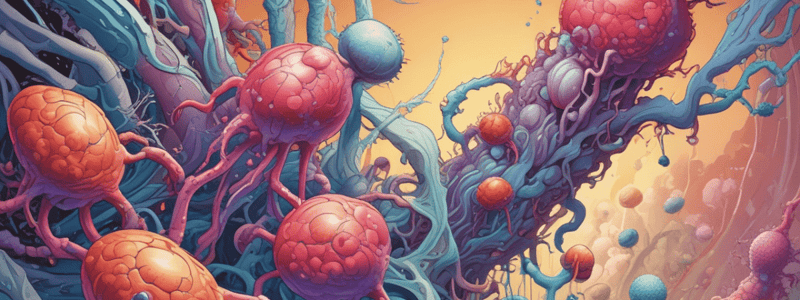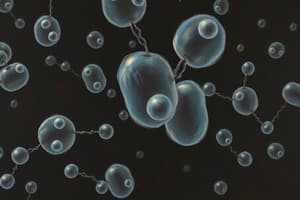Podcast
Questions and Answers
What is the main difference between the two strategies of developing drugs to combat MRSA, and how do they relate to natural selection?
What is the main difference between the two strategies of developing drugs to combat MRSA, and how do they relate to natural selection?
The two strategies are developing drugs that target aureus specifically and developing drugs that slow the growth of MRSA but do not kill it. The first strategy might be effective because it would target the specific bacteria, whereas the second strategy might be effective because it would not exert strong selective pressure, reducing the likelihood of resistance development.
What is homology, and how does it relate to common ancestry?
What is homology, and how does it relate to common ancestry?
Homology is the similarity in characteristics between related species that results from their common ancestry. It is a result of the shared genetic makeup of these species, which leads to similar structures or features that may have different functions.
What is the main prediction of the view of evolution as a remodeling process, and how is it supported by the observation of closely related species?
What is the main prediction of the view of evolution as a remodeling process, and how is it supported by the observation of closely related species?
The main prediction is that closely related species should share similar features, which is supported by the observation that they share many features beyond those used to determine their relationship.
What is the significance of the skeletal structure of mammalian forelimbs, and how does it relate to homology?
What is the significance of the skeletal structure of mammalian forelimbs, and how does it relate to homology?
How does natural selection lead to the adaptation of species over time, and what is the role of environmental conditions in this process?
How does natural selection lead to the adaptation of species over time, and what is the role of environmental conditions in this process?
What is the significance of the fact that bacterial species can exchange genes, and how does it relate to the development of antibiotic resistance?
What is the significance of the fact that bacterial species can exchange genes, and how does it relate to the development of antibiotic resistance?
What is the significance of vestigial structures in organisms, such as the pelvis and leg bones in snakes, and eye remnants in blind cave fishes?
What is the significance of vestigial structures in organisms, such as the pelvis and leg bones in snakes, and eye remnants in blind cave fishes?
What is the importance of the universal genetic code shared among all forms of life?
What is the importance of the universal genetic code shared among all forms of life?
What is the significance of molecular homologies, such as the shared genes between humans and bacteria?
What is the significance of molecular homologies, such as the shared genes between humans and bacteria?
What is the role of pseudogenes in the evolutionary history of an organism?
What is the role of pseudogenes in the evolutionary history of an organism?
What is the significance of anatomical similarities in vertebrate embryos, such as the presence of pharyngeal pouches and post-anal tails?
What is the significance of anatomical similarities in vertebrate embryos, such as the presence of pharyngeal pouches and post-anal tails?
What does the presence of vestigial structures and molecular homologies suggest about the mechanism of evolution?
What does the presence of vestigial structures and molecular homologies suggest about the mechanism of evolution?
What is the significance of the similar arrangement of bones in the forelimbs of mammals, such as humans, cats, whales, and bats, despite their different functions?
What is the significance of the similar arrangement of bones in the forelimbs of mammals, such as humans, cats, whales, and bats, despite their different functions?
What is the importance of comparing early stages of development in different animal species?
What is the importance of comparing early stages of development in different animal species?
What are vestigial structures, and what do they suggest about evolution?
What are vestigial structures, and what do they suggest about evolution?
How does the concept of homologous structures support the idea of gradualism in evolution?
How does the concept of homologous structures support the idea of gradualism in evolution?
What does the presence of vestigial structures contradict?
What does the presence of vestigial structures contradict?
How do anatomical homologies, such as those found in the forelimbs of mammals, support the mechanism of natural selection?
How do anatomical homologies, such as those found in the forelimbs of mammals, support the mechanism of natural selection?
What is the likely outcome of chromosomal mutations that delete or rearrange many gene loci at once?
What is the likely outcome of chromosomal mutations that delete or rearrange many gene loci at once?
What is the role of transposons in the genome?
What is the role of transposons in the genome?
What is the result of gene duplication in terms of new genetic variation?
What is the result of gene duplication in terms of new genetic variation?
Why do mice have a higher percentage of functional olfactory receptor genes compared to humans?
Why do mice have a higher percentage of functional olfactory receptor genes compared to humans?
What is the significance of the dramatic increase in olfactory receptor genes in early mammals?
What is the significance of the dramatic increase in olfactory receptor genes in early mammals?
How do mutation rates vary among organisms?
How do mutation rates vary among organisms?
What is the primary source of new genes and alleles in a population?
What is the primary source of new genes and alleles in a population?
What type of mutation can have a significant impact on an organism's phenotype?
What type of mutation can have a significant impact on an organism's phenotype?
What is the effect of gene flow on the frequency of CW alleles in a population?
What is the effect of gene flow on the frequency of CW alleles in a population?
Why do most mutations in animals not get passed on to offspring?
Why do most mutations in animals not get passed on to offspring?
What can occur when neighboring populations live in different environments?
What can occur when neighboring populations live in different environments?
What is the result of a mutation in a gene that codes for a protein, but does not alter the protein's amino acid composition?
What is the result of a mutation in a gene that codes for a protein, but does not alter the protein's amino acid composition?
What is more likely to occur when the environment is changing?
What is more likely to occur when the environment is changing?
What is the result of extensive gene flow between neighboring populations?
What is the result of extensive gene flow between neighboring populations?
What is the advantage of copper-tolerant alleles in bent grass populations growing near copper mines?
What is the advantage of copper-tolerant alleles in bent grass populations growing near copper mines?
What is the term for a gradual change in a trait along a geographic axis?
What is the term for a gradual change in a trait along a geographic axis?
What can occur when copper-tolerant alleles are transferred to non-mine soils?
What can occur when copper-tolerant alleles are transferred to non-mine soils?
What can be transferred between populations through gene flow?
What can be transferred between populations through gene flow?




